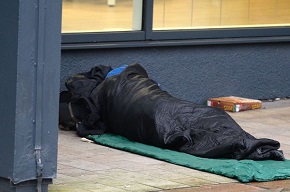Rough Sleeping Strategy
In August 2018, the government unveiled its Rough Sleeping Strategy, with the aim of ending rough sleeping in England by 2027.
It is estimate that 4,750 people sleep rough in England on any given night; a number that has risen over the last seven years.
The government has pledged £100 million to help the homeless, from efforts to prevent them ending up on the streets in the first place, to providing support for mental health and addictions, and further funding for housing.
Around £50m will be used to build more social housing outside London for those who are able to move on from hostels or refuges.
Communities Secretary James Brokenshire conceded that the £100m did not constitute entirely new funding, with half of it being “reprioritised” from existing budgets. He said; "Half of it is already being committed to homelessness and rough sleeping. The other remaining half is money that is new to rough sleeping and homelessness, reflecting and recognising priorities.”
Polly Neate, chief executive of Shelter, said: "This is a step forward and not a total fix for homelessness. We still need to tackle the chronic lack of genuinely affordable homes, deep instability of renting and problems with housing benefit that are leaving so many without a home."
Labour shadow Housing Secretary John Healey said that it was; "a feeble plan that lacks any urgency to tackle the crisis of rising rough sleeping", and reaffirmed that a Labour government would end rough sleeping within its first term by making 8,000 homes available to those with a history of sleeping on the streets.
Ref https://www.gov.uk/government/news/rough-sleeping-strategy-prevention-intervention-recovery
[edit] Find out more
[edit] Related articles on Designing Buildings Wiki
Featured articles and news
Latest Build UK Building Safety Regime explainer published
Key elements in one short, now updated document.
UKGBC launch the UK Climate Resilience Roadmap
First guidance of its kind on direct climate impacts for the built environment and how it can adapt.
CLC Health, Safety and Wellbeing Strategy 2025
Launched by the Minister for Industry to look at fatalities on site, improving mental health and other issues.
One of the most impressive Victorian architects. Book review.
Common Assessment Standard now with building safety
New CAS update now includes mandatory building safety questions.
RTPI leader to become new CIOB Chief Executive Officer
Dr Victoria Hills MRTPI, FICE to take over after Caroline Gumble’s departure.
Social and affordable housing, a long term plan for delivery
The “Delivering a Decade of Renewal for Social and Affordable Housing” strategy sets out future path.
A change to adoptive architecture
Effects of global weather warming on architectural detailing, material choice and human interaction.
The proposed publicly owned and backed subsidiary of Homes England, to facilitate new homes.
How big is the problem and what can we do to mitigate the effects?
Overheating guidance and tools for building designers
A number of cool guides to help with the heat.
The UK's Modern Industrial Strategy: A 10 year plan
Previous consultation criticism, current key elements and general support with some persisting reservations.
Building Safety Regulator reforms
New roles, new staff and a new fast track service pave the way for a single construction regulator.
Architectural Technologist CPDs and Communications
CIAT CPD… and how you can do it!
Cooling centres and cool spaces
Managing extreme heat in cities by directing the public to places for heat stress relief and water sources.
Winter gardens: A brief history and warm variations
Extending the season with glass in different forms and terms.
Restoring Great Yarmouth's Winter Gardens
Transforming one of the least sustainable constructions imaginable.























